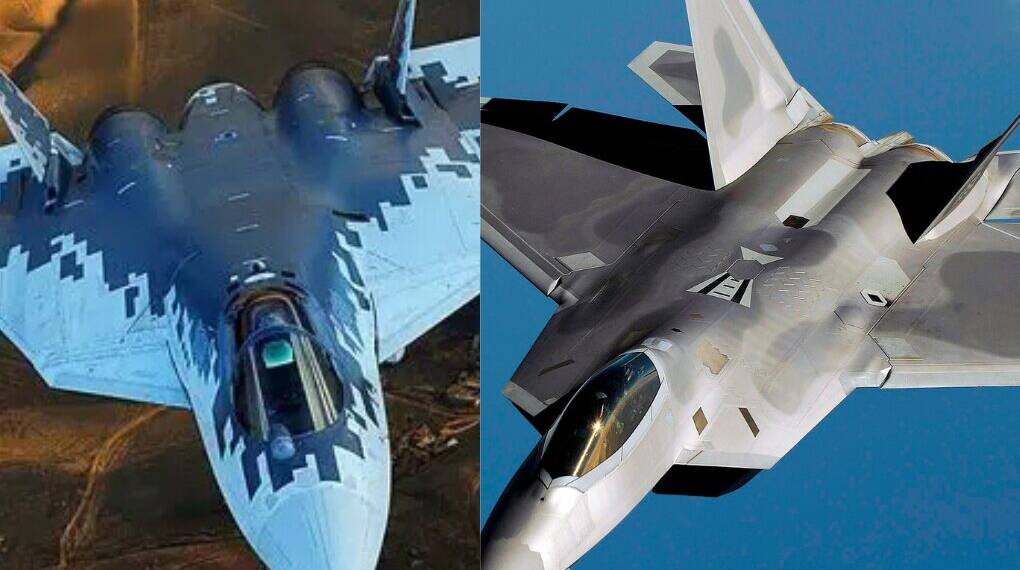Two decades after it redefined modern air combat, the F-22 Raptor continues to cast a long shadow over rival stealth programs worldwide. The US Air Force’s crown jewel, with its unrivaled blend of stealth, speed, and situational awareness, not only set the bar for fifth-generation fighters but also quietly shaped the global defense landscape—including one of its most ambitious but ultimately ill-fated competitors: the Indo-Russian Fifth Generation Fighter Aircraft (FGFA).
The FGFA was once touted as the future of Indian air power—a stealth jet co-developed with Russia’s Sukhoi Design Bureau that would match the F-22 Raptor in capability and replace aging Indian Air Force (IAF) fleets. Instead, it became a textbook case of geopolitical friction, mismatched expectations, and a broader race for technological supremacy where the US emerged a quiet winner.
The Dream That Took Off (But Never Landed)
In January 2007, India and Russia made global headlines at the Aero India airshow by announcing a bold partnership to co-develop a fifth-generation stealth fighter based on Russia’s PAK-FA (later Su-57) platform. Building on the trust and success of earlier collaborations—like the Su-30MKI and BrahMos cruise missile—the FGFA program was envisioned as a 50:50 endeavor, sharing funding, engineering, and intellectual property.
The stakes were high. Russia saw the FGFA as its answer to the F-22 Raptor, while India saw it as a leapfrog opportunity—a chance to co-develop cutting-edge aerospace technology and field a stealth fighter years ahead of rivals like China. The deal initially promised first flights by 2009 and full-scale production by 2015.
But by 2018, the dream had unraveled.
Diverging Visions, Mounting Disappointments
India’s expectations clashed early with Russian priorities. While Russia prioritized a single-seat variant, India wanted a two-seater for strike roles. More critically, India was disillusioned with the platform’s stealth credentials, engine reliability, and the lack of meaningful technology transfer.
Despite investing nearly $300 million in initial studies, the IAF saw little tangible return. The Su-57, which emerged as the basis for FGFA, failed to meet key benchmarks—particularly in radar cross-section and supercruise performance. Analysts at the Center for Strategic and International Studies (CSIS) called its stealth “pseudo” and emphasized its radar visibility was far greater than the F-22 or even the F-35.
When India officially withdrew from the FGFA program in 2018, citing high costs (an estimated $25 billion), poor transparency, and underwhelming capabilities, many saw it as a prudent strategic move.
“India’s exit was a logical decision,” said Richard Aboulafia of the Teal Group. “The Su-57 was overhyped, underdelivering, and didn’t align with India’s long-term aerospace vision.”
Quiet Victory for the U.S.
Though Washington never publicly commented on India’s exit, the strategic implications were clear. The failure of the FGFA weakened Russia’s credibility as a next-gen partner and opened the Indian market to Western—especially American—alternatives. The U.S., already offering advanced platforms like the F-35 and technology partnerships for India’s AMCA (Advanced Medium Combat Aircraft), benefited silently.
Former IAF Chief R.K.S. Bhadauria later confirmed that interim fifth-gen imports were avoided to keep focus on the indigenous AMCA program. His stance reflected New Delhi’s determination to move away from dependency—on either the U.S. or Russia—and build a truly sovereign aerospace capability.
The Su-57’s Long Road to Relevance
Despite being inducted into the Russian Air Force in 2020—over 15 years after the F-22—the Su-57 has faced production delays, export hesitancy, and limited combat use. Sanctions following the Ukraine invasion in 2022 further crippled its supply chains, stalling access to critical components like semiconductors and titanium.
To date, Russia has only inducted a small fleet of Su-57s, which have been used sparingly in Ukraine, primarily in standoff missile roles far from the frontlines. Critics argue its stealth design remains compromised by legacy design philosophies, while the AL-41F1 engine lacks sustained supercruise—something the F-22 mastered in the 2000s.
Yet, Moscow continues to pitch the Su-57 as a capable multirole fighter, highlighting its AESA radar, internal weapons bays, and growing electronic warfare suite. Russian defense experts like Ruslan Pukhov have defended the platform, calling India’s withdrawal shortsighted and politically influenced by Washington.
The F-22 Nears Retirement as a New Race Begins
Ironically, as the Su-57 begins its life cycle, the F-22 Raptor nears retirement. The USAF is expected to retire older Block 20 models and may phase out the fleet by the late 2030s. Still, even in its twilight, the Raptor remains unmatched. Notably, it “shot down” its Su-57 rival—not in combat—but in the geopolitical marketplace, by rendering its existence strategically irrelevant.
The U.S. has already moved ahead with the Next Generation Air Dominance (NGAD) program, with the F-47 sixth-generation fighter entering serial production by 2029. While details remain classified, reports indicate capabilities far beyond the Raptor, including drone teaming, adaptive engines, and advanced AI-assisted avionics.
India’s New Dilemma: Return to Russia?
Despite past disappointments, the Su-57 may not be out of India’s equation. With China rapidly deploying its J-20 stealth fighters and advancing toward sixth-generation platforms, India faces pressure to field a credible stealth deterrent.
Russia has reopened talks, and reports suggest the IAF is reconsidering Su-57 acquisitions—not as a primary combat platform, but perhaps as a stop gap or technology bridge until the indigenous AMCA is ready by early 2030s.
The question remains: Will India gamble again on the Felon, or will it stay the course toward self-reliance?
A Tale of Two Fighters and One Strategic Pivot
The F-22 Raptor didn’t just outfly its rivals—it reshaped global fighter procurement strategies. Its symbolic victory over the Su-57, and by extension the FGFA, underscores a hard truth in modern air warfare: superior technology is not just built—it’s maintained through transparency, adaptability, and strategic partnerships.
India’s decision to walk away from the FGFA program may have been costly in the short term, but it arguably protected the country from deeper dependency and propelled a more ambitious, indigenous aerospace vision.
As the sixth-generation era approaches, one thing is clear: stealth isn’t just about radar signatures—it’s about making the right decisions before the enemy sees you coming.








